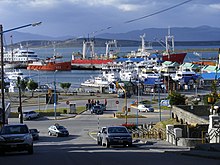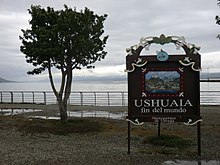Ushuaia

|
||
| Basic data | ||
|---|---|---|
| Surface: | 23 km 2 | |
| location | 54 ° 48 ′ S , 68 ° 18 ′ W | |
| Height above d. M .: | 6 m | |
| Population (2015): | 67,600 | |
| Density: | 2939 inhabitants / km² | |
|
|
||
| administration | ||
| Province : |
|
|
| Department : | Ushuaia | |
| Mayor: | Federico Sciurano | |
| Others | ||
| Postal code : | V9410 | |
| Telephone code: | 02901 | |
| Ushuaia website | ||
Ushuaia [ uˈswaʝa ] is the southernmost city in Argentina and is located on the Beagle Channel . The word "Ushuaia" comes from the language of the indigenous people Yámana and means something like "bay that looks to the east".
Ushuaia competes with to Chile belonging to Puerto Williams on the island Navarino for the title, southernmost city in the world to be. Puerto Williams is located to the south, but according to Chilean law it is not a city (ciudad), but a village (pueblo). Ushuaia, with latitude 54 ° 48 'south, is further away from the South Pole than Moscow, with latitude 55 ° 44' north from the North Pole .
geography
The city is located on the south side of the Great Tierra del Fuego Island ( Isla Grande de Tierra del Fuego ) on the Beagle Channel . Ushuaia is the capital of the Argentine province of Tierra del Fuego (German: "Tierra del Fuego").
climate
The maritime climate is balanced and relatively cold and humid all year round. The weather can be very changeable during the day. Often there is a low south of the southern tip of South America. For Tierra del Fuego this low results in a westerly wind, which is strongly deflected and weakened in the lower layers of the air by the mountains.
In winter the temperatures are between −6 and 8 ° C, in summer, however, between 5 and 20 ° C. The extreme values are 29.5 ° C in January and −21.0 ° C in July.
|
Average monthly temperatures and rainfall for Ushuaia
Source:
|
|||||||||||||||||||||||||||||||||||||||||||||||||||||||||||||||||||||||||||||||||||||||||||||||||||||||||||||||||||||||||||||||||||||||||||||||||||||||||||||||||||||||||||||||||||||||||||||||||||
history

English missionaries invaded the area from around 1870. In 1884 the naval forces captured Ushuaia for Argentina. The construction of the Presidio , which began in 1902, was significant for urban development . This prison , completed in 1920, replaced the one on Isla de los Estados . The convicts , predominantly violent criminals but also political prisoners , built the Ferrocarril Austral Fueguino narrow-gauge railway , with which tourists now travel through the Tierra del Fuego National Park . The prison was dissolved in 1947. A combination of several museums is now housed in this building . On the one hand there is the Museo Presidio on the history of the prison; on the other hand there is a museum of shipping in the region and one of the history of the Antarctic expeditions , many of which started from Ushuaia. The writer Ricardo Rojas was one of the most famous prisoners of the Presidio . Carlos Gardel was also believed to be detained in Ushuaia Prison when he was a teenager. A diary shows that Carlos Gardel was in Ushuaia for two months; but he was not imprisoned in the Presidio.
population
At the 2001 census , Ushuaia had 46,000 residents. The number of inhabitants grew rapidly, especially because of the tax advantages of its residents, and according to the Ushuaia city administration, in 2005 it was around 64,000. According to the results of the latest census of October 27, 2010, the city had 56,825 inhabitants.
| year | 2003 | 2004 | 2005 | 2010 |
|---|---|---|---|---|
| Residents | 57,927 | 60,927 | 64.107 | 56,825 |
economy
tourism
The proximity to Tierra del Fuego National Park and the unique nature of the area helped Ushuaia to attract a significant number of tourists . Ushuaia is also popular as a starting point for Antarctic expeditions and a stopover for cruise ships . Since almost all goods have to be brought into the city over long distances, Ushuaia is also one of the most expensive cities in Argentina and all of South America .
A tourist destination is the Museo del Fin del Mundo ("Museum of the End of the World"), which was established in 1979 in the former headquarters of the Argentine Central Bank ( Banco Central de la República Argentina ). It attaches importance to the preservation of the natural and historical features of Tierra del Fuego.
From the Glaciar Martial glacier near Ushuaia you have a wide view of the city, the Chilean mountains opposite the Beagle Channel and the Faro del Fin del Mundo ( lighthouse ).
The southernmost ski area in the world, which opened in 1999 at Cerro Castor, 26 kilometers from Ushuaia, also attracts tourists mainly from Argentina and Brazil. The ski area was also the venue for larger events such as the FIS Freestyle World Cup 2012 or the Interski Congress 2015.
Ushuaia shows a connection to its history in its old historical architecture. Many European expeditions have come to this area to research the climate, geography, flora and fauna and the Indian tribes. Modern urban development, on the other hand, lacks any planning or order and results in an uncontrolled proliferation of urban architecture.
The collection of webcam photos of the location is unique because it is not a stationary webcam . Every day around 30 photos of the city and the surrounding area are made by hand and in good quality. The photos are archived until 2004 and can be rated and commented on.
traffic
Ushuaia has an international airport, the Aeropuerto Internacional de Ushuaia Malvinas Argentinas ( IATA code : USH ), which mainly offers flights to Buenos Aires , but also to other destinations in Argentina.
Ushuaia is also an important port for cruise ships , some of which start their way to Antarctica from here or anchor before continuing south.
The road Ruta Nacional 3 (part of the Panamericana ), which leads from Rio Grande over the Paso Garibaldi to Ushuaia, ends here.
Ushuaia is home to the management of the Ferrocarril Austral Fueguino railway line , which ends eight kilometers west of the city.
Town twinning
Ushuaia has twinned cities with:
-
 Santos , Brazil, since September 22, 1994
Santos , Brazil, since September 22, 1994 -
 Punta Arenas , Chile, since June 21, 1995
Punta Arenas , Chile, since June 21, 1995 -
 Eilat , Israel, since 1995
Eilat , Israel, since 1995 -
 Utqiaġvik , Alaska , USA
Utqiaġvik , Alaska , USA -
 Hammerfest , Norway
Hammerfest , Norway -
 San Miguel de Allende , Mexico
San Miguel de Allende , Mexico -
 Nuuk , Greenland
Nuuk , Greenland -
 Unkel , Germany, Rhineland-Palatinate
Unkel , Germany, Rhineland-Palatinate
-
 Lazio , Italy
Lazio , Italy
Personalities
- Stephen Lucas Bridges (1874–1949), writer, ethnographer and farmer
Web links
- Portal of Ushuaia (Spanish)
- IFAM population data (Spanish)
- Tourist information (Spanish)
- Tierra del Fuego Tourism Institute with webcam (span., Engl.)
Individual evidence
- ↑ Chile: División Político-Administrativa y Censal 2001. (PDF; 412 kB) Instituto Nacional De Estadisticas, 2001, p. 10 , accessed on February 25, 2013 (Spanish).
- ↑ wetterkontor.de
- ↑ El Diario del Fin del Mundo. Retrieved February 16, 2013 .
- ↑ Estadisticas. Archived from the original on January 12, 2007 ; Retrieved January 22, 2007 .
- ↑ Censo 2010 Argentina. Archived from the original on August 24, 2011 ; Retrieved December 20, 2012 .
- ↑ Cerro Castor, esquiando en el fin del mundo - Ushuaia, Patagonia, Argentina. Retrieved August 10, 2019 .
- ^ Interski-Austria. Retrieved August 10, 2019 .







